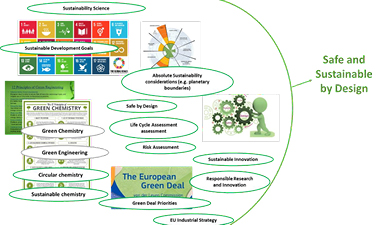Regulatory Review: August–September 2023
Trudy Watson-Leung, SETAC
Given increasingly busy schedules, we all benefit from digests that give us a quick way to review the news, hot research and upcoming due dates. We thought it would be beneficial to keep an eye on upcoming regulatory developments, forums, webinars and other events pertaining to chemical regulation for the SETAC audience. We encourage you to share any pertinent and useful items with us by sending them to [email protected].
European Chemicals Agency (ECHA) and the European Union (EU)
ECHA Will Make Batteries More Sustainable Through Their Lifecycle
The Batteries Regulation 2023/1542 of the European Parliament came into force on 17 August. In 2024, ECHA will develop a commission to report to the EU on substances of concern associated with batteries and their manufacturing. The report will identify substances and consider follow-up measures, such as EU-wide restrictions.
PFHxS Are Now Officially Persistent Organic Pollutants (POPs)
On 28 August, the addition of perfluorohexane sulfonic acid (PFHxS), its salts and PFHxS-related compounds into Annex 1 of Regulation (EU) 2019/1021 came into force.
Shortlisted Chemical Alternatives Table Now Available
On 16 August, the European Chemical Agency (ACHE) shared a file containing key information on potential alternatives to Annex XIV substance(s), extracted from Analysis of Alternatives (AoAs) that was submitted by companies applying for authorization under Registration, Evaluation, Authorisation and Restriction of Chemicals Regulation of the EU (REACH) on potential Annex VIV alternatives.
EU Strategy for Sustainable and Circular Textiles
The EU published an update to it’s Factsheet on the lifecycle of textile products and proposed coordinated actions to change how textiles and produced and consumed within the context of the European Green Deal, the Circular Economy Action Plan and the European industrial strategy.
Environment and Climate Change Canada (ECCC)
ECCC Will Hold Information Sessions on the Canadian Right to a Healthy Environment
In June 2023, Bill S-5,Strengthening Environmental Protection for a Healthier Canada Act became law changing the Canadian Environmental Protection Act 1999 (CEPA) for the first time in more than 20 years. With this Bill, the government of Canada recognizes that every individual in Canada has a right to a healthy environment (“the Right”) as provided under CEPA. On 3 October (English) and 4 October (French) information sessions will be held for those interested to learn more.
United States Environmental Protection Agency (USEPA)
USEPA Released Draft Strategy to Better Protect Endangered Species From Herbicide Use
The draft strategy describes proposed early mitigations for more than 900 listed species and designated critical habitats. The current chemical-by-chemical, species-by-species approach has led to the USEPA only meeting its Endangered Species Act (ESA) obligations for less than 5% of its actions. Through the multichemical, multispecies approach in the Strategy, the USEPA will identify and begin mitigating for potential impacts even before ESA consultations are completed. View the documents and public comments on the draft.
USEPA Committed Millions to Advancing Water Equity and Access for All
The USEPA’S Advancing Water Equity and Access for All Commitment will invest US$500 million to provide technical assistance to help communities invest in water infrastructure in 1,500 disadvantaged communities across the country.
USEPA Released a Guide to Terms Used to Describe the Standing of USEPA Methods
The USEPA released a document to help external parties understand the various terms used for EPA methods, such as promulgated, approved, regulatory, published and peer reviewed, put in the Federal Register, etc. This document will help external parties to determine which USEPA methods to use when doing work that needs to be reported to the USEPA or other federal agencies.
State of the Practice of Onsite Leachate Treatment at Municipal Solid Waste Landfills Document Released
Due to a growing reluctance of municipal wastewater treatment plant operators to accept often highly contaminated municipal solid waste landfill leachate, there is a need for landfill owners to explore onsite treatment options. The report reviews the state of onsite treatment processes and technologies in the U.S. Selected case study sites highlight the wide range of methods, costs and goals associated with leachate treatment and outline variables that affect the design of the leachate treatment system.
Intergovernmental Forum on Mining, Minerals, Metals and Sustainable Development (IGF)
Relinquishment of Closed Mine Sites: Policy Steps for Governments
The IGF, with more than 80 member countries, hosted by the International Institute for Sustainable Development (IISD), released a report on the relinquishment of closed mines. The report reviews the concept of relinquishment and provides a high-level scan of global practices and policy. The report spotlights key challenges and issues that governments should consider when developing relinquishment protocols and discusses a series of recommended steps to relinquishment.
IGF Case Study: Environmental and Social Impact Assessments in Mining Legal Frameworks
The IGF released a report on the main components of a legal framework for environmental and social impact assessments (ESIAs) in mining using case studies from USA, Kazakhstan and Australia. The case studies show the value of leadership and ongoing evaluation in developing and improving ESIA legal frameworks, the benefit of looking for assistance and feedback from outside the jurisdiction, and that there is always room for improvement, irrespective of the economic development stage and political situation.
The French Packaging Council
France Released Recommendations on Environmental Claims on Packaging
The French Packaging Council published it’s views and recommendations regarding environmental claims on product packaging. The goal of the document is to help companies draw up environmental information on their packaging and to act as a watchdog for any environmental claims that do not comply with regulations or good practice.
Author's contact: [email protected]





